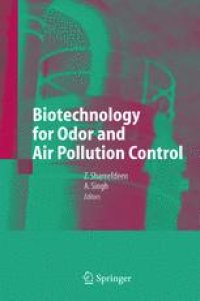
Ebook: Biotechnology for Odor and Air Pollution Control
Author: Zarook Shareefdeen Brian Herner Ajay Singh (auth.) Dr. Zarook Shareefdeen Dr. Ajay Singh (eds.)
- Tags: Biotechnology, Biochemical Engineering, Atmospheric Protection/Air Quality Control/Air Pollution, Applied Microbiology, Microbiology, Industrial and Production Engineering
- Year: 2005
- Publisher: Springer Berlin Heidelberg
- Language: English
- pdf
Many industrial processes cause volatile organic and inorganic odorous compounds to be emitted in large quantities. These compounds create hazards to the ecosystem and to humans. The demand for odor and air pollution control systems that provide breathable air is therefore growing. Biotechnology offers one of the most economical and environmentally friendly methods for controlling odor and air pollution.
Here is the first book on biotechnological processes for controlling odor and air pollution emanating from industrial and municipal airstreams. An international team of authors from academia and industry describe biotechnological methods ranging from those in laboratory stages to pilot evaluation to full-scale process implementation.
Topics include bioprocesses for the treatment of odors and air pollutants in wastewater treatment plants, rendering plants, chemical production facilities, and food and flavor manufacturing facilities. In addition to the basic microbiology and engineering, the design, modeling, and control of bioreactors are discussed in detail.
Many industrial processes cause volatile organic and inorganic odorous compounds to be emitted in large quantities. These compounds create hazards to the ecosystem and to humans. The demand for odor and air pollution control systems that provide breathable air is therefore growing. Biotechnology offers one of the most economical and environmentally friendly methods for controlling odor and air pollution.
Here is the first book on biotechnological processes for controlling odor and air pollution emanating from industrial and municipal airstreams. An international team of authors from academia and industry describe biotechnological methods ranging from those in laboratory stages to pilot evaluation to full-scale process implementation.
Topics include bioprocesses for the treatment of odors and air pollutants in wastewater treatment plants, rendering plants, chemical production facilities, and food and flavor manufacturing facilities. In addition to the basic microbiology and engineering, the design, modeling, and control of bioreactors are discussed in detail.
Content:
Front Matter....Pages I-XVIII
Biotechnology for Air Pollution Control — an Overview....Pages 3-15
Environmental Laws and Regulations Related to Odor and Waste Gas Contaminants....Pages 17-28
Methods of Odor and VOC Control....Pages 29-63
Selection of Bioreactor Media for Odor Control....Pages 65-100
Microbiology of Bioreactors for Waste Gas Treatment....Pages 101-121
Biofilter Technology....Pages 125-145
Biotrickling Filter Technology....Pages 147-168
Bioscrubber Technology....Pages 169-193
Membrane Bioreactor Technology....Pages 195-212
Modeling of Biofilters and Biotrickling Filters for Odor and VOC Control Applications....Pages 213-231
Biofilter Design and Operation for Odor Control — The New Zealand Experience....Pages 235-252
Biological Treatment of Waste Gases Containing Inorganic Compounds....Pages 253-279
Biological Treatment of Waste Gases Containing Volatile Organic Compounds....Pages 281-302
Odor Removal in Industrial Facilities....Pages 305-326
Odor Removal in Municipal Wastewater Treatment Plants — Case Studies....Pages 327-353
Biotrickling and Bioscrubber Applications to Control Odor and Air Pollutants: Developments, Implementation Issues and Case Studies....Pages 355-379
Future Prospects of Biotechnology for Odor Control....Pages 383-401
Back Matter....Pages 403-409
Many industrial processes cause volatile organic and inorganic odorous compounds to be emitted in large quantities. These compounds create hazards to the ecosystem and to humans. The demand for odor and air pollution control systems that provide breathable air is therefore growing. Biotechnology offers one of the most economical and environmentally friendly methods for controlling odor and air pollution.
Here is the first book on biotechnological processes for controlling odor and air pollution emanating from industrial and municipal airstreams. An international team of authors from academia and industry describe biotechnological methods ranging from those in laboratory stages to pilot evaluation to full-scale process implementation.
Topics include bioprocesses for the treatment of odors and air pollutants in wastewater treatment plants, rendering plants, chemical production facilities, and food and flavor manufacturing facilities. In addition to the basic microbiology and engineering, the design, modeling, and control of bioreactors are discussed in detail.
Content:
Front Matter....Pages I-XVIII
Biotechnology for Air Pollution Control — an Overview....Pages 3-15
Environmental Laws and Regulations Related to Odor and Waste Gas Contaminants....Pages 17-28
Methods of Odor and VOC Control....Pages 29-63
Selection of Bioreactor Media for Odor Control....Pages 65-100
Microbiology of Bioreactors for Waste Gas Treatment....Pages 101-121
Biofilter Technology....Pages 125-145
Biotrickling Filter Technology....Pages 147-168
Bioscrubber Technology....Pages 169-193
Membrane Bioreactor Technology....Pages 195-212
Modeling of Biofilters and Biotrickling Filters for Odor and VOC Control Applications....Pages 213-231
Biofilter Design and Operation for Odor Control — The New Zealand Experience....Pages 235-252
Biological Treatment of Waste Gases Containing Inorganic Compounds....Pages 253-279
Biological Treatment of Waste Gases Containing Volatile Organic Compounds....Pages 281-302
Odor Removal in Industrial Facilities....Pages 305-326
Odor Removal in Municipal Wastewater Treatment Plants — Case Studies....Pages 327-353
Biotrickling and Bioscrubber Applications to Control Odor and Air Pollutants: Developments, Implementation Issues and Case Studies....Pages 355-379
Future Prospects of Biotechnology for Odor Control....Pages 383-401
Back Matter....Pages 403-409
....